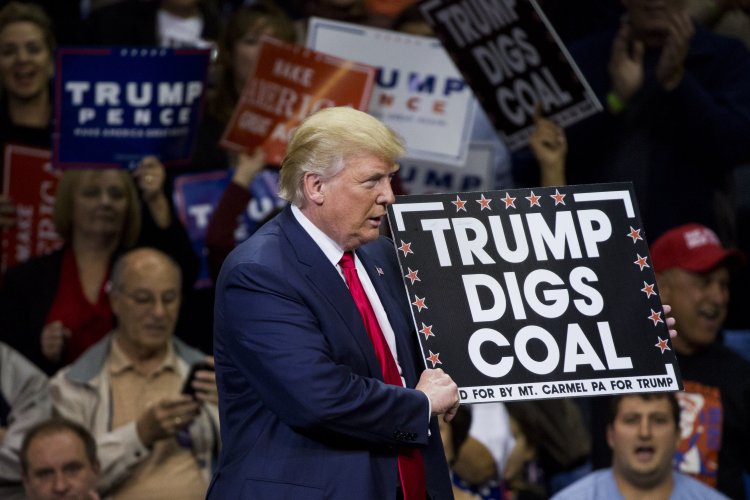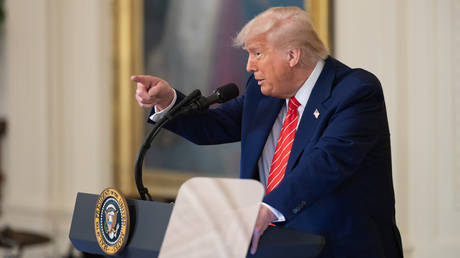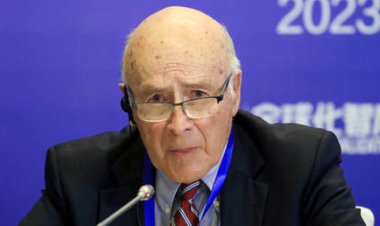Trump’s new objective: Resurrect a significant climate pollutant shunned by power markets
Even those Republicans and executives who support coal acknowledge that it won't restore the industry to its previous heights.

These actions, initially covered by PMG on Monday, involve the use of emergency powers to breathe new life into a coal sector that has faced challenges for decades, largely due to stringent environmental regulations and competition from cheaper natural gas and renewable energy sources.
While some industry proponents acknowledged that Trump's orders might not reverse coal's significant decline from its previously dominant position as a source of U.S. electricity, they nonetheless signify a stark shift from the Biden administration's agenda, which anticipated the closure of additional coal plants and emphasized the phasing out of all greenhouse gas-emitting power plants.
If successful, Trump's initiatives could also substantially increase the emission of greenhouse gases, running counter to prior U.S. efforts to eliminate climate pollution over the next several decades.
“We are bringing back an industry that was abandoned despite the fact it was just about the best in terms of power — real power,” Trump asserted during remarks at the White House, flanked by coal workers in hard hats. “We are ending Joe Biden’s war on beautiful clean coal once and for all."
The four executive orders signed by Trump are designed to eliminate perceived barriers to increasing coal production in the United States, including opening public lands for coal leasing. Additionally, he is advocating for coal to fuel artificial intelligence data centers, which are expected to significantly boost electricity demand in the upcoming years.
Among the orders is one that directs Interior Secretary Doug Burgum, who leads the president’s Energy Dominance Council, to classify coal as a “mineral.” This reclassification is intended to enhance production, in line with a previous executive order aimed at expediting permits for domestic mineral production. The order also instructs relevant agencies to remove restrictions on mining activities to bolster output, as outlined in a fact sheet.
These executive actions expand on regulatory measures the Trump administration has already initiated to support the beleaguered coal industry. Environmental Protection Agency Administrator Lee Zeldin has begun reviewing a range of regulations impacting coal plants, including significant climate policies and measures that impose stricter limits on air toxins, wastewater discharge, and coal ash. In a recent move, the Trump administration invited coal plants to seek a special exemption from intensified Biden-era emission limits related to mercury and other air pollutants.
This marks not the first attempt by Trump to resuscitate the struggling coal sector. During his first term, former Energy Secretary Rick Perry proposed a rule advocating for financial support to keep coal and nuclear plants operational; however, this proposal was ultimately rejected by the Republican-controlled Federal Energy Regulatory Commission.
Nonetheless, Trump faces an uphill battle in reversing the market forces that have driven coal's long-term decline. The higher operational costs of less efficient coal plants combined with lower prices for natural gas and renewable energy are significant hurdles.
As reported by the Energy Information Administration, coal production in 2023 fell to less than half of its 2008 peak, influenced by rising mining costs, environmental regulations, and the competition from gas and renewables.
"Under the first Trump administration, coal capacity retired at a faster rate compared to any other administration,” noted Ben Jealous, the executive director of the Sierra Club, which led a "Beyond Coal" campaign claiming credit for the retirement of nearly 100 coal plants during Trump's first term and a total of 389. “Just as we did then, we will not back down from Trump and his dangerous and deadly plans."
One of Trump's executive orders instructs the Energy Secretary to keep essential power plants operational to avert potential energy shortages, authorizing emergency measures to prevent the shutdown of large power plants if it would jeopardize system reliability.
Another order mandates that the Energy Department determine whether metallurgical coal qualifies as a “critical material” or “critical mineral” under the Energy Act of 2020 — a designation that would facilitate funding for research into new technologies. The outlook for metallurgical coal, primarily used in blast furnace steelmaking, appears somewhat more favorable than that for coal used in electricity generation. The U.S. exports the majority of the metallurgical coal it produces, competing on the international market against countries like Australia, Russia, and Canada.
The Trump administration plans to engage the Energy Department’s Loan Programs Office to back coal-fired electricity generation. In a series of posts on X, the department announced that $200 billion would be made available through its energy infrastructure reinvestment program — established under the Inflation Reduction Act — to provide “low-cost, long-term financing available to invest in energy infrastructure, including coal.”
Additionally, the department intends to reinstate the National Coal Council, which will include representatives from coal producers, users, equipment suppliers, state and local officials, and others within the coal value chain. In contrast, the Biden administration aimed to reorient this initiative to focus on coal workers and their communities.
While Trump's policies seem likely to prolong the operation of existing coal plants, utilities have consistently expressed disinterest in constructing new coal facilities.
"The industry right now is kind of holding its own,” remarked Sen. Shelley Moore Capito, chair of the Environment and Public Works Committee, in a brief interview with PMG. “What [the executive order] will do is elongate the use of coal as a power source — to keep [up with] this insatiable need that we’re going to have for energy.”
An energy executive, speaking anonymously, suggested that the executive orders may not significantly alter the long-term prospects for the struggling fuel.
“The EO will likely help in the short term to ensure dispatchable resources are retained for some period of time, but long-term investment decisions on assets that last 40 years or more can’t realistically be made on the back of an EO that can simply be reversed in the next administration,” the executive stated.
Furthermore, coal plants incur significantly higher operating costs compared to natural gas, wind, and solar facilities. For the first time last year, wind and solar surpassed coal-fired generation in the U.S., with natural gas having maintained its status as the country’s primary electricity source since 2018.
"The economics are pretty much impossible already,” texted Rep. Jared Huffman, the ranking member of the House Natural Resources Committee, to PMG. “So adding in trade wars and tariffs would seem to make it even less likely that the Golden Age of coal is upon us.”
A utility and energy consultant, granted anonymity to speak openly about the orders, questioned Trump’s focus on coal in light of the clear market shift towards natural gas over the past decade.
“As much as I love coal, the chief reason it went away is not necessarily regulations. Natural gas and fracking is why coal went away,” said the consultant. “Texas put coal out of business."
According to research from clean energy think tank Energy Innovation, the relative cost of coal compared to renewable energy has continued to increase over the past six years, propelled by incentives from the Democrats’ climate law. The organization reports that wind, solar, and storage are more affordable to operate than 99 percent of all coal plants. Prior to the Inflation Reduction Act’s passage in 2022, 72 percent of coal plants were already more costly to manage than wind and solar.
Rob Gramlich, president of power grid consulting firm Grid Strategies and a former economic adviser at FERC, conveyed via email that the fundamental economics underlying coal plants are likely to remain unchanged despite the president’s initiatives, and added that fossil fuel plants are generally expected to stay in operation longer due to surging electricity demand.
“I don’t think this order changes the facts that coal-fired power plants are old, expensive to run, and unlikely to operate very often or for many more years,” Gramlich stated. “The plants will likely be kept online longer than believed a few years ago due to an uptick in power demand. But that is unrelated to this order, and doesn’t mean the plants will operate outside of peak periods to maintain reliability.”
Nevertheless, some Republicans support Trump’s initiatives, arguing that the U.S. must continue to develop coal to stay competitive with China in the quest to power data centers and artificial intelligence.
“For years, Democrats have held coal captive with reckless regulations, making it harder for us to use American energy and making us more dependent on foreign sources of energy,” remarked Sen. John Barrasso, whose home state is the nation’s leading coal producer, on the Senate floor Tuesday while showcasing a large piece of coal. “President Trump is cutting red tape so we can compete again. Clean coal is a fuel for the future. It’s affordable, it’s reliable, ready to go."
Ramin Sohrabi for TROIB News
Discover more Science and Technology news updates in TROIB Sci-Tech












